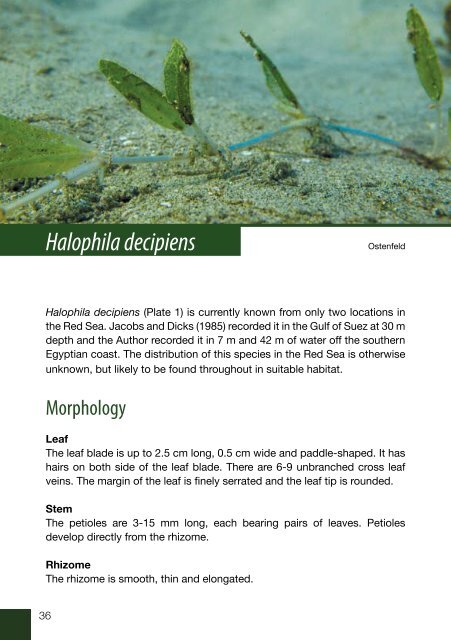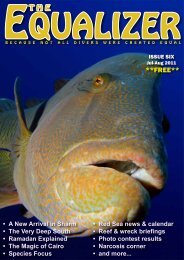Field Guide to Seagrasses of the Red Sea - Seagrass-Watch
Field Guide to Seagrasses of the Red Sea - Seagrass-Watch
Field Guide to Seagrasses of the Red Sea - Seagrass-Watch
Create successful ePaper yourself
Turn your PDF publications into a flip-book with our unique Google optimized e-Paper software.
Halophila decipiens<br />
Ostenfeld<br />
Halophila decipiens (Plate 1) is currently known from only two locations in<br />
<strong>the</strong> <strong>Red</strong> <strong>Sea</strong>. Jacobs and Dicks (1985) recorded it in <strong>the</strong> Gulf <strong>of</strong> Suez at 30 m<br />
depth and <strong>the</strong> Author recorded it in 7 m and 42 m <strong>of</strong> water <strong>of</strong>f <strong>the</strong> sou<strong>the</strong>rn<br />
Egyptian coast. The distribution <strong>of</strong> this species in <strong>the</strong> <strong>Red</strong> <strong>Sea</strong> is o<strong>the</strong>rwise<br />
unknown, but likely <strong>to</strong> be found throughout in suitable habitat.<br />
Morphology<br />
Leaf<br />
The leaf blade is up <strong>to</strong> 2.5 cm long, 0.5 cm wide and paddle-shaped. It has<br />
hairs on both side <strong>of</strong> <strong>the</strong> leaf blade. There are 6-9 unbranched cross leaf<br />
veins. The margin <strong>of</strong> <strong>the</strong> leaf is finely serrated and <strong>the</strong> leaf tip is rounded.<br />
Stem<br />
The petioles are 3-15 mm long, each bearing pairs <strong>of</strong> leaves. Petioles<br />
develop directly from <strong>the</strong> rhizome.<br />
Rhizome<br />
The rhizome is smooth, thin and elongated.<br />
36





